Business Finance Report: UTL, Madagascar Industries Financial Analysis
VerifiedAdded on 2023/01/16
|19
|3917
|63
Report
AI Summary
This report delves into the intricacies of business finance, focusing on working capital management and cash flow analysis within the context of UberTools Ltd (UTL) and Madagascar Industries. The report examines the relationship between cash flow and profit, emphasizing the importance of effective working capital management, including receivables, payables, and inventory. It analyzes how changes in working capital impact cash flows and provides recommendations for UTL to improve its cash flow issues. Furthermore, the report explores various financial ratios, such as sales growth, gross profit margin, operating profit margin, and gearing, to assess the financial performance of businesses. The analysis includes the calculation and interpretation of these ratios for Madagascar Industries, offering insights into its financial health and performance trends. The report concludes by suggesting strategies for Boards to evaluate the financial performance of a business, providing a comprehensive overview of financial management principles and their practical application.
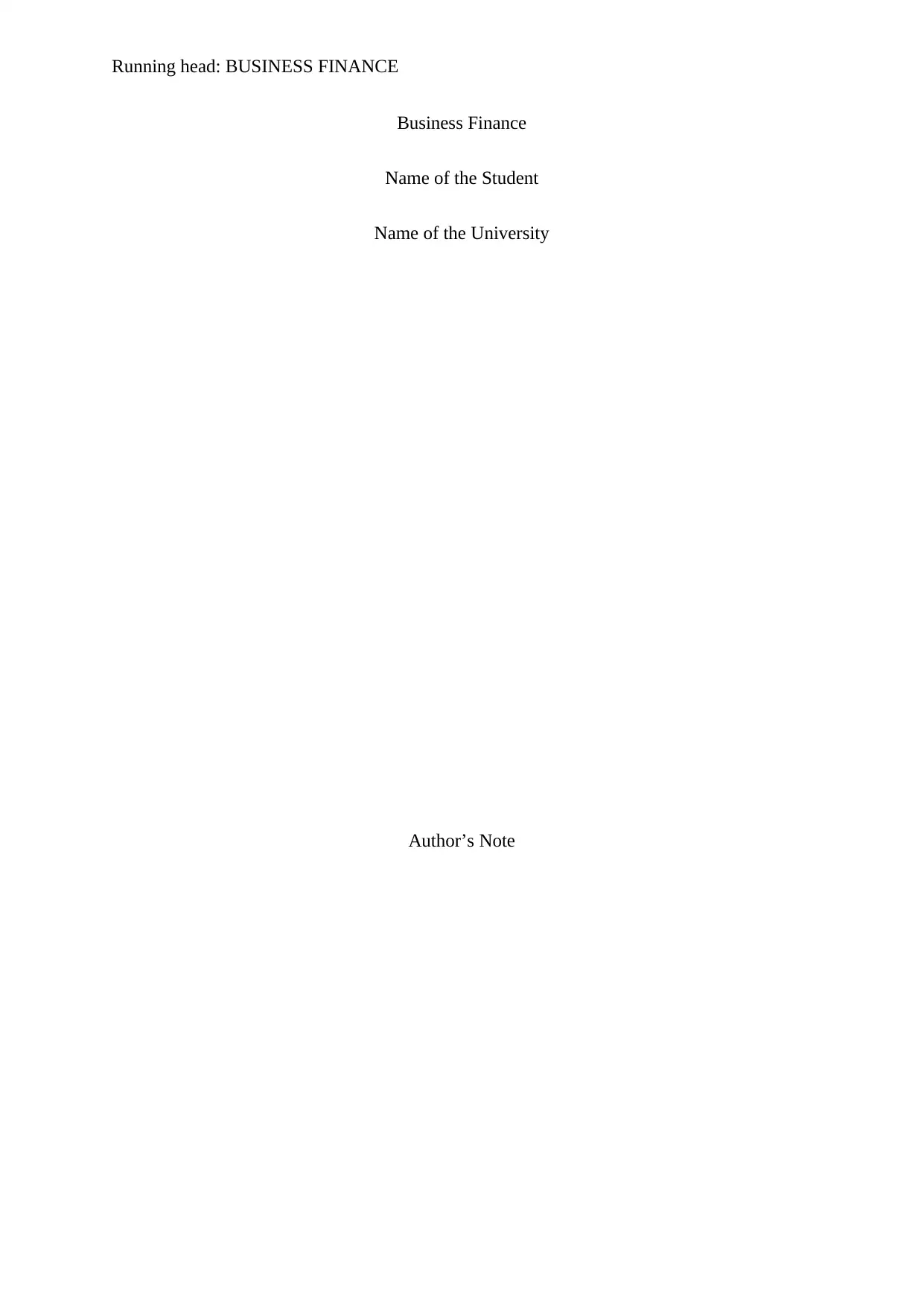
Running head: BUSINESS FINANCE
Business Finance
Name of the Student
Name of the University
Author’s Note
Business Finance
Name of the Student
Name of the University
Author’s Note
Paraphrase This Document
Need a fresh take? Get an instant paraphrase of this document with our AI Paraphraser
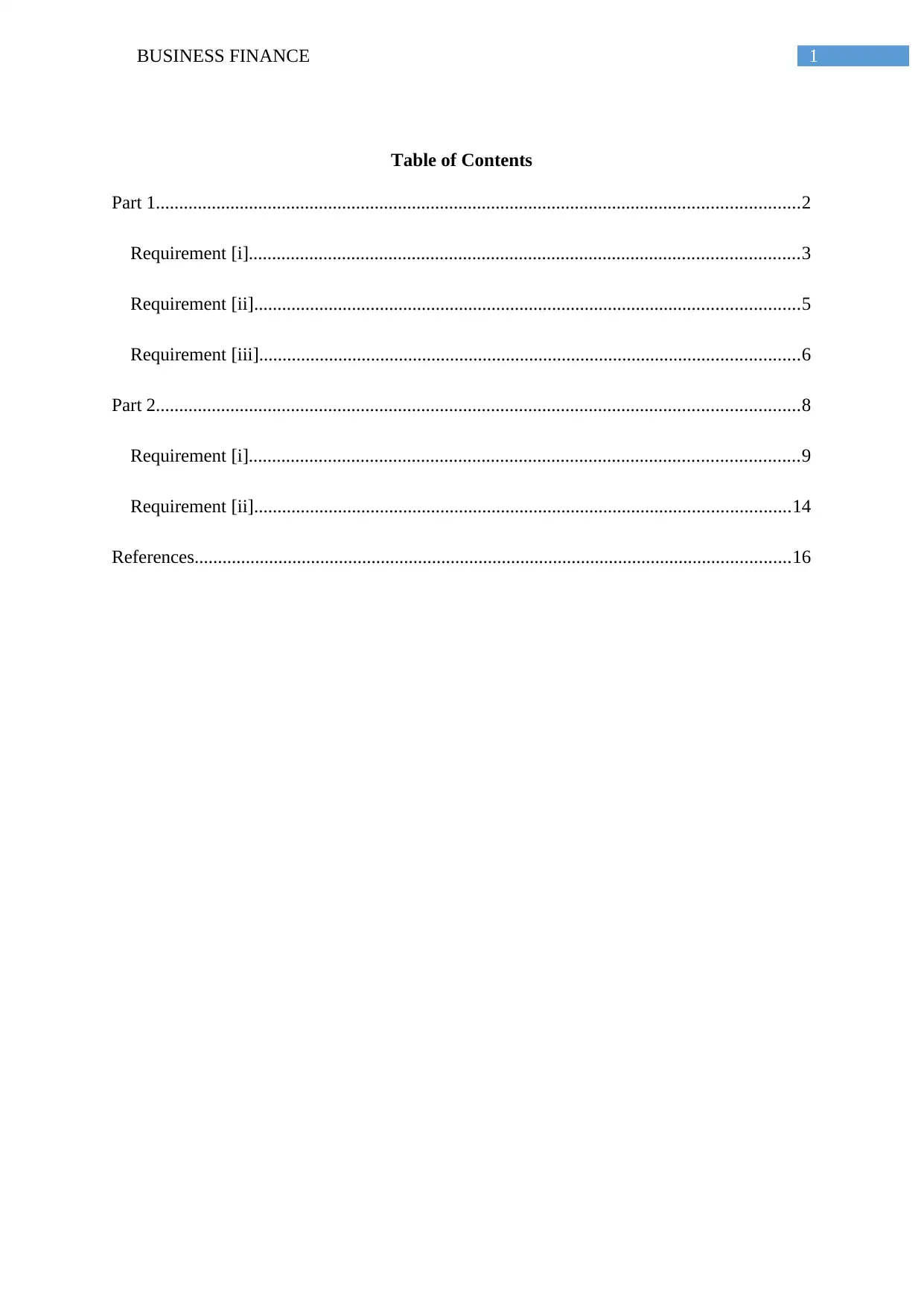
1BUSINESS FINANCE
Table of Contents
Part 1..........................................................................................................................................2
Requirement [i]......................................................................................................................3
Requirement [ii].....................................................................................................................5
Requirement [iii]....................................................................................................................6
Part 2..........................................................................................................................................8
Requirement [i]......................................................................................................................9
Requirement [ii]...................................................................................................................14
References................................................................................................................................16
Table of Contents
Part 1..........................................................................................................................................2
Requirement [i]......................................................................................................................3
Requirement [ii].....................................................................................................................5
Requirement [iii]....................................................................................................................6
Part 2..........................................................................................................................................8
Requirement [i]......................................................................................................................9
Requirement [ii]...................................................................................................................14
References................................................................................................................................16
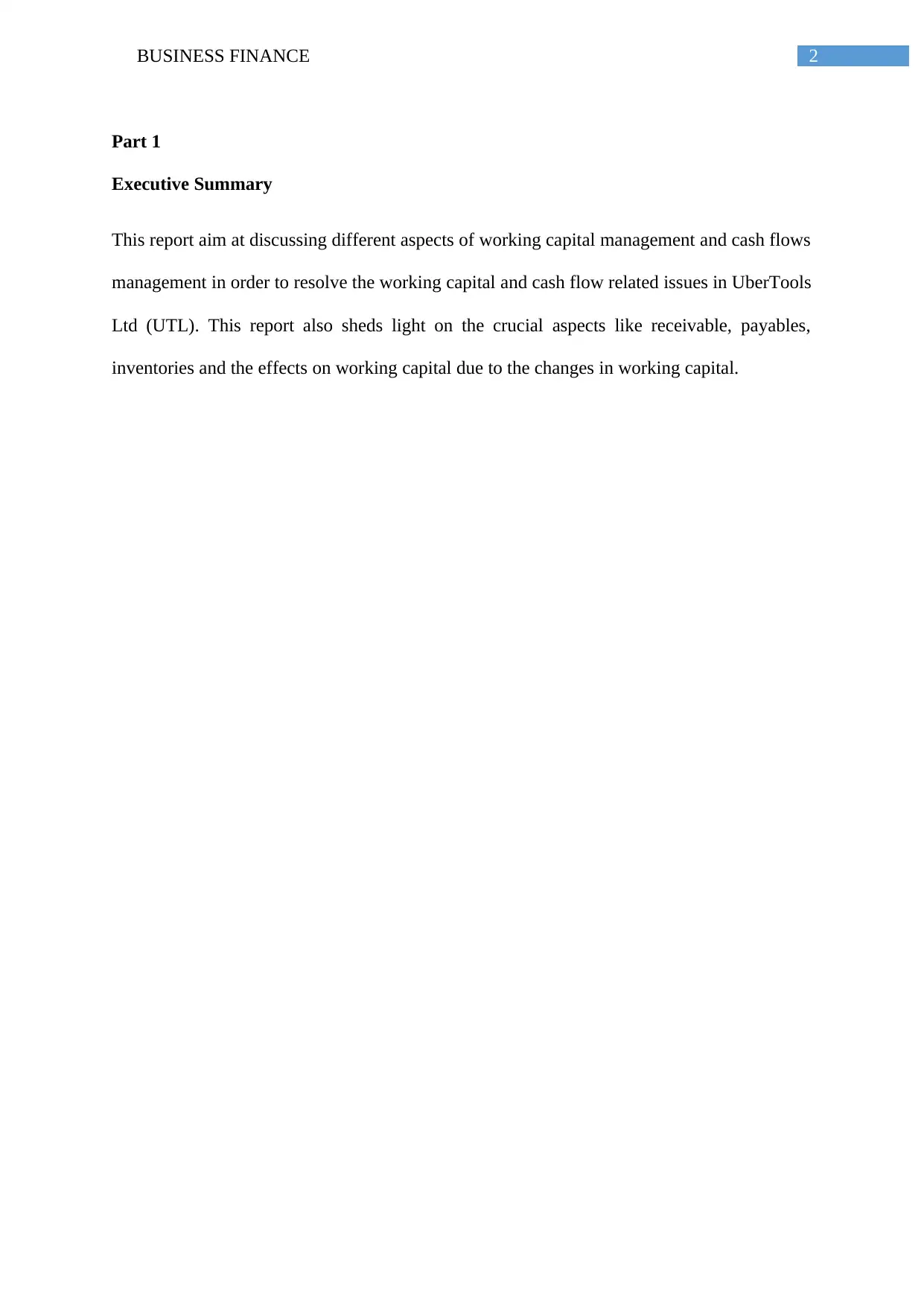
2BUSINESS FINANCE
Part 1
Executive Summary
This report aim at discussing different aspects of working capital management and cash flows
management in order to resolve the working capital and cash flow related issues in UberTools
Ltd (UTL). This report also sheds light on the crucial aspects like receivable, payables,
inventories and the effects on working capital due to the changes in working capital.
Part 1
Executive Summary
This report aim at discussing different aspects of working capital management and cash flows
management in order to resolve the working capital and cash flow related issues in UberTools
Ltd (UTL). This report also sheds light on the crucial aspects like receivable, payables,
inventories and the effects on working capital due to the changes in working capital.
⊘ This is a preview!⊘
Do you want full access?
Subscribe today to unlock all pages.

Trusted by 1+ million students worldwide
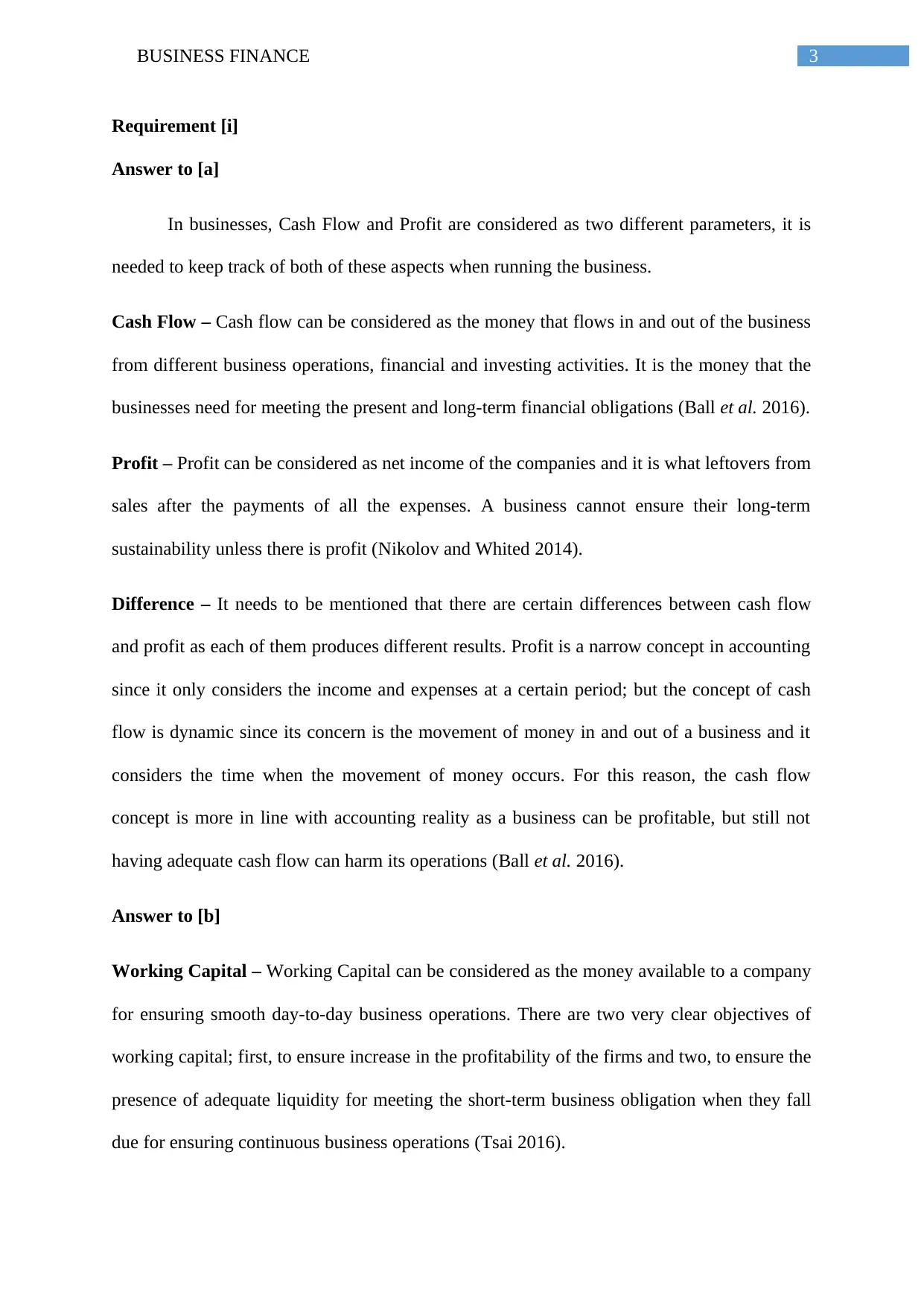
3BUSINESS FINANCE
Requirement [i]
Answer to [a]
In businesses, Cash Flow and Profit are considered as two different parameters, it is
needed to keep track of both of these aspects when running the business.
Cash Flow – Cash flow can be considered as the money that flows in and out of the business
from different business operations, financial and investing activities. It is the money that the
businesses need for meeting the present and long-term financial obligations (Ball et al. 2016).
Profit – Profit can be considered as net income of the companies and it is what leftovers from
sales after the payments of all the expenses. A business cannot ensure their long-term
sustainability unless there is profit (Nikolov and Whited 2014).
Difference – It needs to be mentioned that there are certain differences between cash flow
and profit as each of them produces different results. Profit is a narrow concept in accounting
since it only considers the income and expenses at a certain period; but the concept of cash
flow is dynamic since its concern is the movement of money in and out of a business and it
considers the time when the movement of money occurs. For this reason, the cash flow
concept is more in line with accounting reality as a business can be profitable, but still not
having adequate cash flow can harm its operations (Ball et al. 2016).
Answer to [b]
Working Capital – Working Capital can be considered as the money available to a company
for ensuring smooth day-to-day business operations. There are two very clear objectives of
working capital; first, to ensure increase in the profitability of the firms and two, to ensure the
presence of adequate liquidity for meeting the short-term business obligation when they fall
due for ensuring continuous business operations (Tsai 2016).
Requirement [i]
Answer to [a]
In businesses, Cash Flow and Profit are considered as two different parameters, it is
needed to keep track of both of these aspects when running the business.
Cash Flow – Cash flow can be considered as the money that flows in and out of the business
from different business operations, financial and investing activities. It is the money that the
businesses need for meeting the present and long-term financial obligations (Ball et al. 2016).
Profit – Profit can be considered as net income of the companies and it is what leftovers from
sales after the payments of all the expenses. A business cannot ensure their long-term
sustainability unless there is profit (Nikolov and Whited 2014).
Difference – It needs to be mentioned that there are certain differences between cash flow
and profit as each of them produces different results. Profit is a narrow concept in accounting
since it only considers the income and expenses at a certain period; but the concept of cash
flow is dynamic since its concern is the movement of money in and out of a business and it
considers the time when the movement of money occurs. For this reason, the cash flow
concept is more in line with accounting reality as a business can be profitable, but still not
having adequate cash flow can harm its operations (Ball et al. 2016).
Answer to [b]
Working Capital – Working Capital can be considered as the money available to a company
for ensuring smooth day-to-day business operations. There are two very clear objectives of
working capital; first, to ensure increase in the profitability of the firms and two, to ensure the
presence of adequate liquidity for meeting the short-term business obligation when they fall
due for ensuring continuous business operations (Tsai 2016).
Paraphrase This Document
Need a fresh take? Get an instant paraphrase of this document with our AI Paraphraser
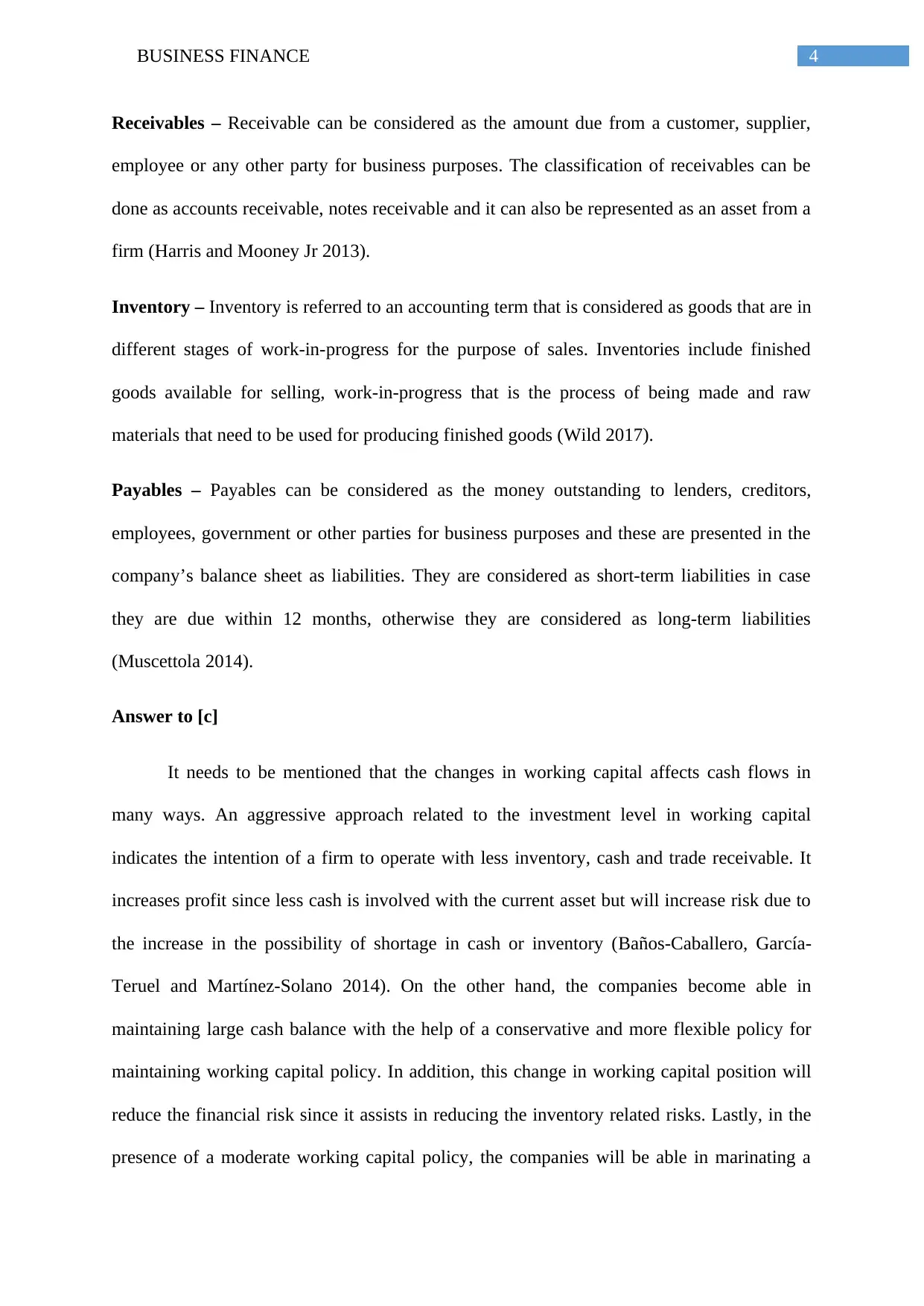
4BUSINESS FINANCE
Receivables – Receivable can be considered as the amount due from a customer, supplier,
employee or any other party for business purposes. The classification of receivables can be
done as accounts receivable, notes receivable and it can also be represented as an asset from a
firm (Harris and Mooney Jr 2013).
Inventory – Inventory is referred to an accounting term that is considered as goods that are in
different stages of work-in-progress for the purpose of sales. Inventories include finished
goods available for selling, work-in-progress that is the process of being made and raw
materials that need to be used for producing finished goods (Wild 2017).
Payables – Payables can be considered as the money outstanding to lenders, creditors,
employees, government or other parties for business purposes and these are presented in the
company’s balance sheet as liabilities. They are considered as short-term liabilities in case
they are due within 12 months, otherwise they are considered as long-term liabilities
(Muscettola 2014).
Answer to [c]
It needs to be mentioned that the changes in working capital affects cash flows in
many ways. An aggressive approach related to the investment level in working capital
indicates the intention of a firm to operate with less inventory, cash and trade receivable. It
increases profit since less cash is involved with the current asset but will increase risk due to
the increase in the possibility of shortage in cash or inventory (Baños-Caballero, García-
Teruel and Martínez-Solano 2014). On the other hand, the companies become able in
maintaining large cash balance with the help of a conservative and more flexible policy for
maintaining working capital policy. In addition, this change in working capital position will
reduce the financial risk since it assists in reducing the inventory related risks. Lastly, in the
presence of a moderate working capital policy, the companies will be able in marinating a
Receivables – Receivable can be considered as the amount due from a customer, supplier,
employee or any other party for business purposes. The classification of receivables can be
done as accounts receivable, notes receivable and it can also be represented as an asset from a
firm (Harris and Mooney Jr 2013).
Inventory – Inventory is referred to an accounting term that is considered as goods that are in
different stages of work-in-progress for the purpose of sales. Inventories include finished
goods available for selling, work-in-progress that is the process of being made and raw
materials that need to be used for producing finished goods (Wild 2017).
Payables – Payables can be considered as the money outstanding to lenders, creditors,
employees, government or other parties for business purposes and these are presented in the
company’s balance sheet as liabilities. They are considered as short-term liabilities in case
they are due within 12 months, otherwise they are considered as long-term liabilities
(Muscettola 2014).
Answer to [c]
It needs to be mentioned that the changes in working capital affects cash flows in
many ways. An aggressive approach related to the investment level in working capital
indicates the intention of a firm to operate with less inventory, cash and trade receivable. It
increases profit since less cash is involved with the current asset but will increase risk due to
the increase in the possibility of shortage in cash or inventory (Baños-Caballero, García-
Teruel and Martínez-Solano 2014). On the other hand, the companies become able in
maintaining large cash balance with the help of a conservative and more flexible policy for
maintaining working capital policy. In addition, this change in working capital position will
reduce the financial risk since it assists in reducing the inventory related risks. Lastly, in the
presence of a moderate working capital policy, the companies will be able in marinating a
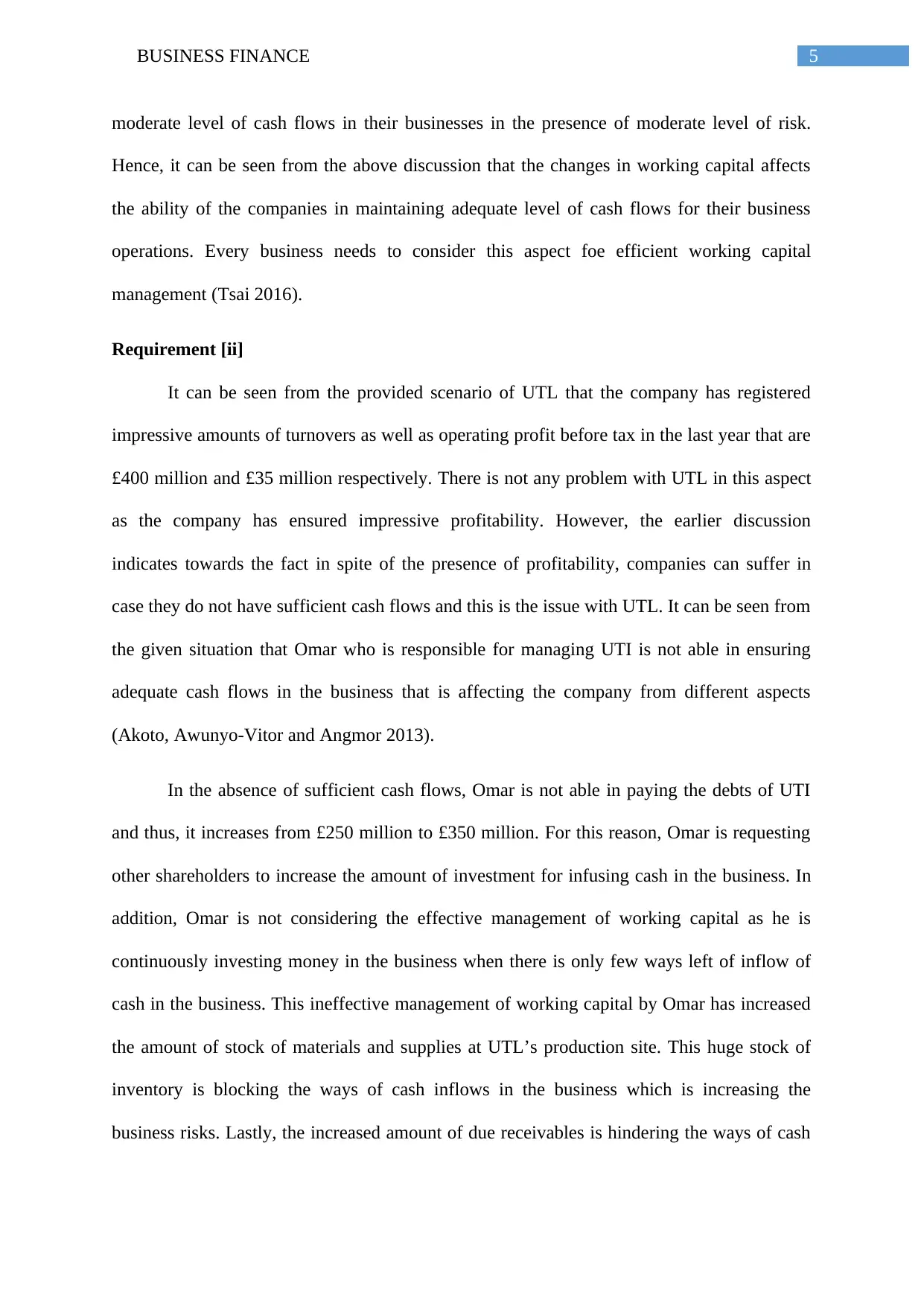
5BUSINESS FINANCE
moderate level of cash flows in their businesses in the presence of moderate level of risk.
Hence, it can be seen from the above discussion that the changes in working capital affects
the ability of the companies in maintaining adequate level of cash flows for their business
operations. Every business needs to consider this aspect foe efficient working capital
management (Tsai 2016).
Requirement [ii]
It can be seen from the provided scenario of UTL that the company has registered
impressive amounts of turnovers as well as operating profit before tax in the last year that are
£400 million and £35 million respectively. There is not any problem with UTL in this aspect
as the company has ensured impressive profitability. However, the earlier discussion
indicates towards the fact in spite of the presence of profitability, companies can suffer in
case they do not have sufficient cash flows and this is the issue with UTL. It can be seen from
the given situation that Omar who is responsible for managing UTI is not able in ensuring
adequate cash flows in the business that is affecting the company from different aspects
(Akoto, Awunyo-Vitor and Angmor 2013).
In the absence of sufficient cash flows, Omar is not able in paying the debts of UTI
and thus, it increases from £250 million to £350 million. For this reason, Omar is requesting
other shareholders to increase the amount of investment for infusing cash in the business. In
addition, Omar is not considering the effective management of working capital as he is
continuously investing money in the business when there is only few ways left of inflow of
cash in the business. This ineffective management of working capital by Omar has increased
the amount of stock of materials and supplies at UTL’s production site. This huge stock of
inventory is blocking the ways of cash inflows in the business which is increasing the
business risks. Lastly, the increased amount of due receivables is hindering the ways of cash
moderate level of cash flows in their businesses in the presence of moderate level of risk.
Hence, it can be seen from the above discussion that the changes in working capital affects
the ability of the companies in maintaining adequate level of cash flows for their business
operations. Every business needs to consider this aspect foe efficient working capital
management (Tsai 2016).
Requirement [ii]
It can be seen from the provided scenario of UTL that the company has registered
impressive amounts of turnovers as well as operating profit before tax in the last year that are
£400 million and £35 million respectively. There is not any problem with UTL in this aspect
as the company has ensured impressive profitability. However, the earlier discussion
indicates towards the fact in spite of the presence of profitability, companies can suffer in
case they do not have sufficient cash flows and this is the issue with UTL. It can be seen from
the given situation that Omar who is responsible for managing UTI is not able in ensuring
adequate cash flows in the business that is affecting the company from different aspects
(Akoto, Awunyo-Vitor and Angmor 2013).
In the absence of sufficient cash flows, Omar is not able in paying the debts of UTI
and thus, it increases from £250 million to £350 million. For this reason, Omar is requesting
other shareholders to increase the amount of investment for infusing cash in the business. In
addition, Omar is not considering the effective management of working capital as he is
continuously investing money in the business when there is only few ways left of inflow of
cash in the business. This ineffective management of working capital by Omar has increased
the amount of stock of materials and supplies at UTL’s production site. This huge stock of
inventory is blocking the ways of cash inflows in the business which is increasing the
business risks. Lastly, the increased amount of due receivables is hindering the ways of cash
⊘ This is a preview!⊘
Do you want full access?
Subscribe today to unlock all pages.

Trusted by 1+ million students worldwide
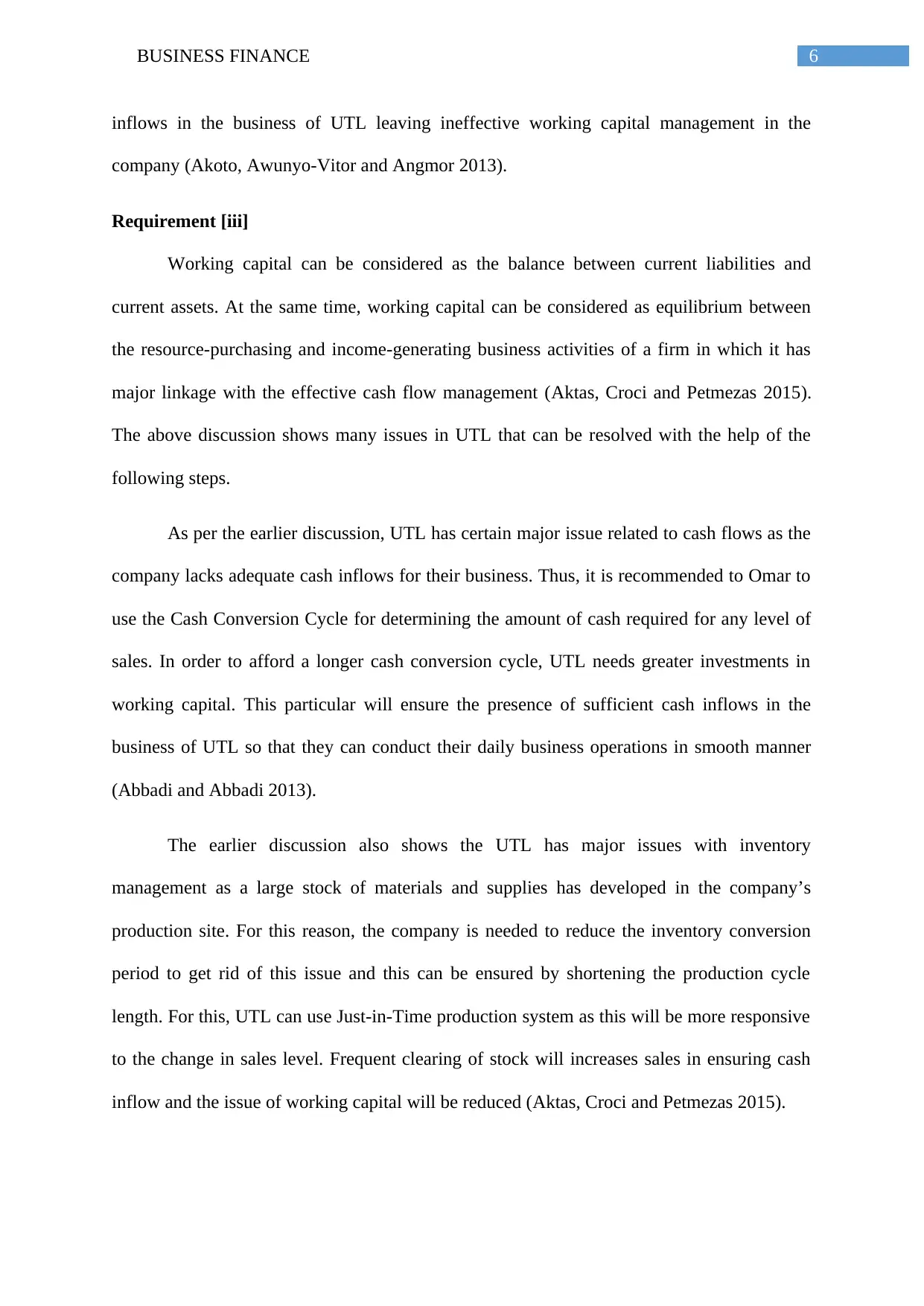
6BUSINESS FINANCE
inflows in the business of UTL leaving ineffective working capital management in the
company (Akoto, Awunyo-Vitor and Angmor 2013).
Requirement [iii]
Working capital can be considered as the balance between current liabilities and
current assets. At the same time, working capital can be considered as equilibrium between
the resource-purchasing and income-generating business activities of a firm in which it has
major linkage with the effective cash flow management (Aktas, Croci and Petmezas 2015).
The above discussion shows many issues in UTL that can be resolved with the help of the
following steps.
As per the earlier discussion, UTL has certain major issue related to cash flows as the
company lacks adequate cash inflows for their business. Thus, it is recommended to Omar to
use the Cash Conversion Cycle for determining the amount of cash required for any level of
sales. In order to afford a longer cash conversion cycle, UTL needs greater investments in
working capital. This particular will ensure the presence of sufficient cash inflows in the
business of UTL so that they can conduct their daily business operations in smooth manner
(Abbadi and Abbadi 2013).
The earlier discussion also shows the UTL has major issues with inventory
management as a large stock of materials and supplies has developed in the company’s
production site. For this reason, the company is needed to reduce the inventory conversion
period to get rid of this issue and this can be ensured by shortening the production cycle
length. For this, UTL can use Just-in-Time production system as this will be more responsive
to the change in sales level. Frequent clearing of stock will increases sales in ensuring cash
inflow and the issue of working capital will be reduced (Aktas, Croci and Petmezas 2015).
inflows in the business of UTL leaving ineffective working capital management in the
company (Akoto, Awunyo-Vitor and Angmor 2013).
Requirement [iii]
Working capital can be considered as the balance between current liabilities and
current assets. At the same time, working capital can be considered as equilibrium between
the resource-purchasing and income-generating business activities of a firm in which it has
major linkage with the effective cash flow management (Aktas, Croci and Petmezas 2015).
The above discussion shows many issues in UTL that can be resolved with the help of the
following steps.
As per the earlier discussion, UTL has certain major issue related to cash flows as the
company lacks adequate cash inflows for their business. Thus, it is recommended to Omar to
use the Cash Conversion Cycle for determining the amount of cash required for any level of
sales. In order to afford a longer cash conversion cycle, UTL needs greater investments in
working capital. This particular will ensure the presence of sufficient cash inflows in the
business of UTL so that they can conduct their daily business operations in smooth manner
(Abbadi and Abbadi 2013).
The earlier discussion also shows the UTL has major issues with inventory
management as a large stock of materials and supplies has developed in the company’s
production site. For this reason, the company is needed to reduce the inventory conversion
period to get rid of this issue and this can be ensured by shortening the production cycle
length. For this, UTL can use Just-in-Time production system as this will be more responsive
to the change in sales level. Frequent clearing of stock will increases sales in ensuring cash
inflow and the issue of working capital will be reduced (Aktas, Croci and Petmezas 2015).
Paraphrase This Document
Need a fresh take? Get an instant paraphrase of this document with our AI Paraphraser
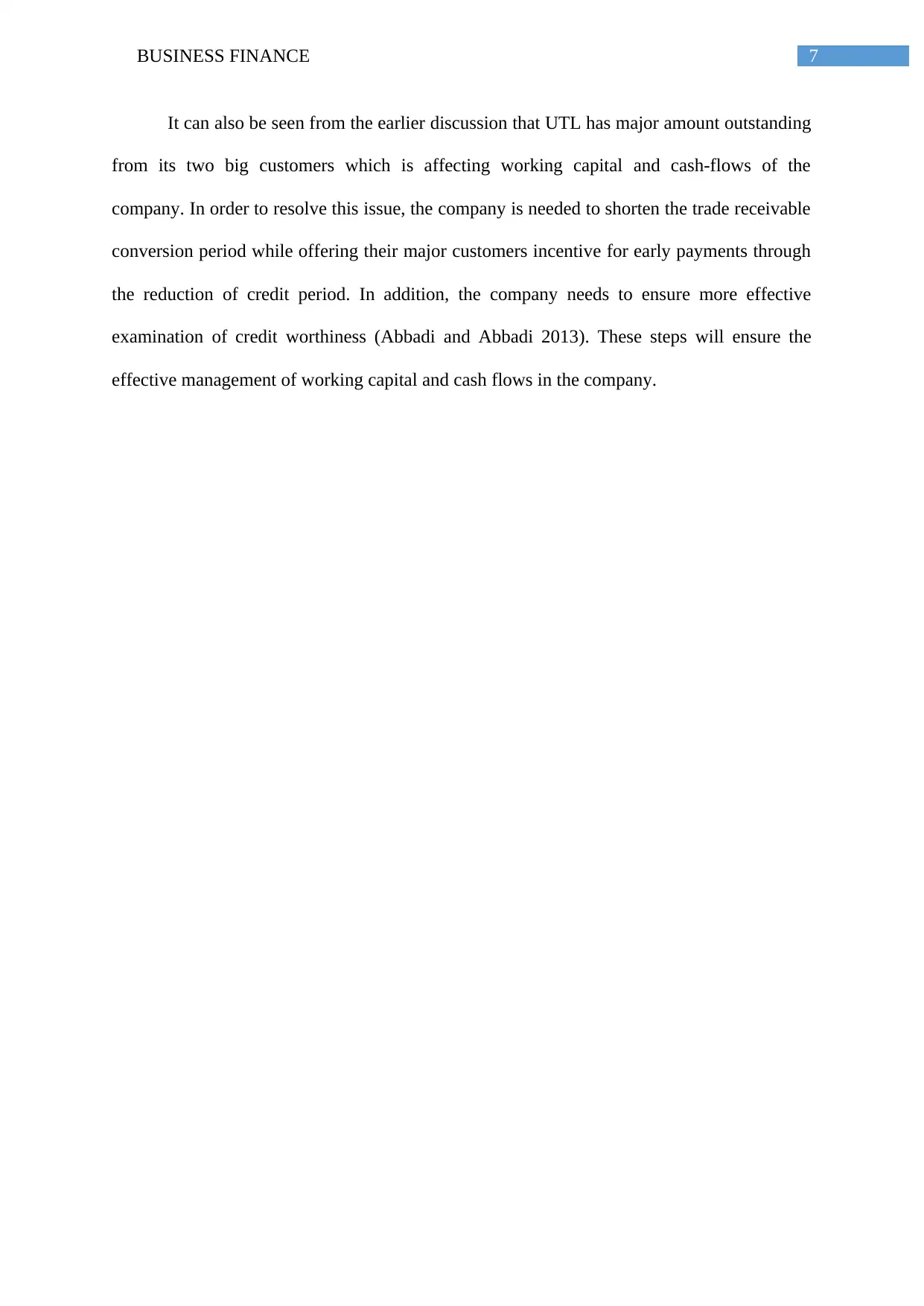
7BUSINESS FINANCE
It can also be seen from the earlier discussion that UTL has major amount outstanding
from its two big customers which is affecting working capital and cash-flows of the
company. In order to resolve this issue, the company is needed to shorten the trade receivable
conversion period while offering their major customers incentive for early payments through
the reduction of credit period. In addition, the company needs to ensure more effective
examination of credit worthiness (Abbadi and Abbadi 2013). These steps will ensure the
effective management of working capital and cash flows in the company.
It can also be seen from the earlier discussion that UTL has major amount outstanding
from its two big customers which is affecting working capital and cash-flows of the
company. In order to resolve this issue, the company is needed to shorten the trade receivable
conversion period while offering their major customers incentive for early payments through
the reduction of credit period. In addition, the company needs to ensure more effective
examination of credit worthiness (Abbadi and Abbadi 2013). These steps will ensure the
effective management of working capital and cash flows in the company.
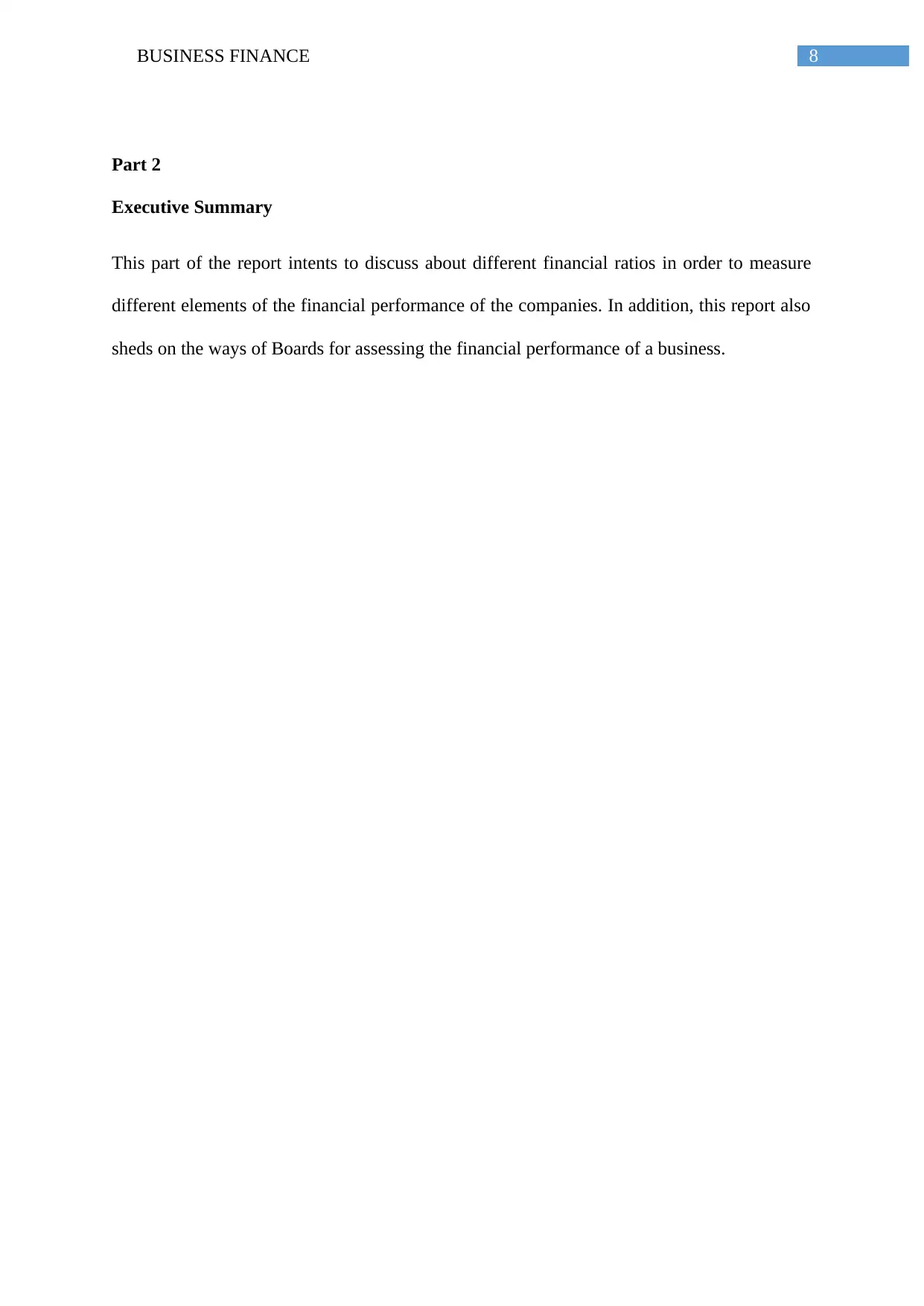
8BUSINESS FINANCE
Part 2
Executive Summary
This part of the report intents to discuss about different financial ratios in order to measure
different elements of the financial performance of the companies. In addition, this report also
sheds on the ways of Boards for assessing the financial performance of a business.
Part 2
Executive Summary
This part of the report intents to discuss about different financial ratios in order to measure
different elements of the financial performance of the companies. In addition, this report also
sheds on the ways of Boards for assessing the financial performance of a business.
⊘ This is a preview!⊘
Do you want full access?
Subscribe today to unlock all pages.

Trusted by 1+ million students worldwide
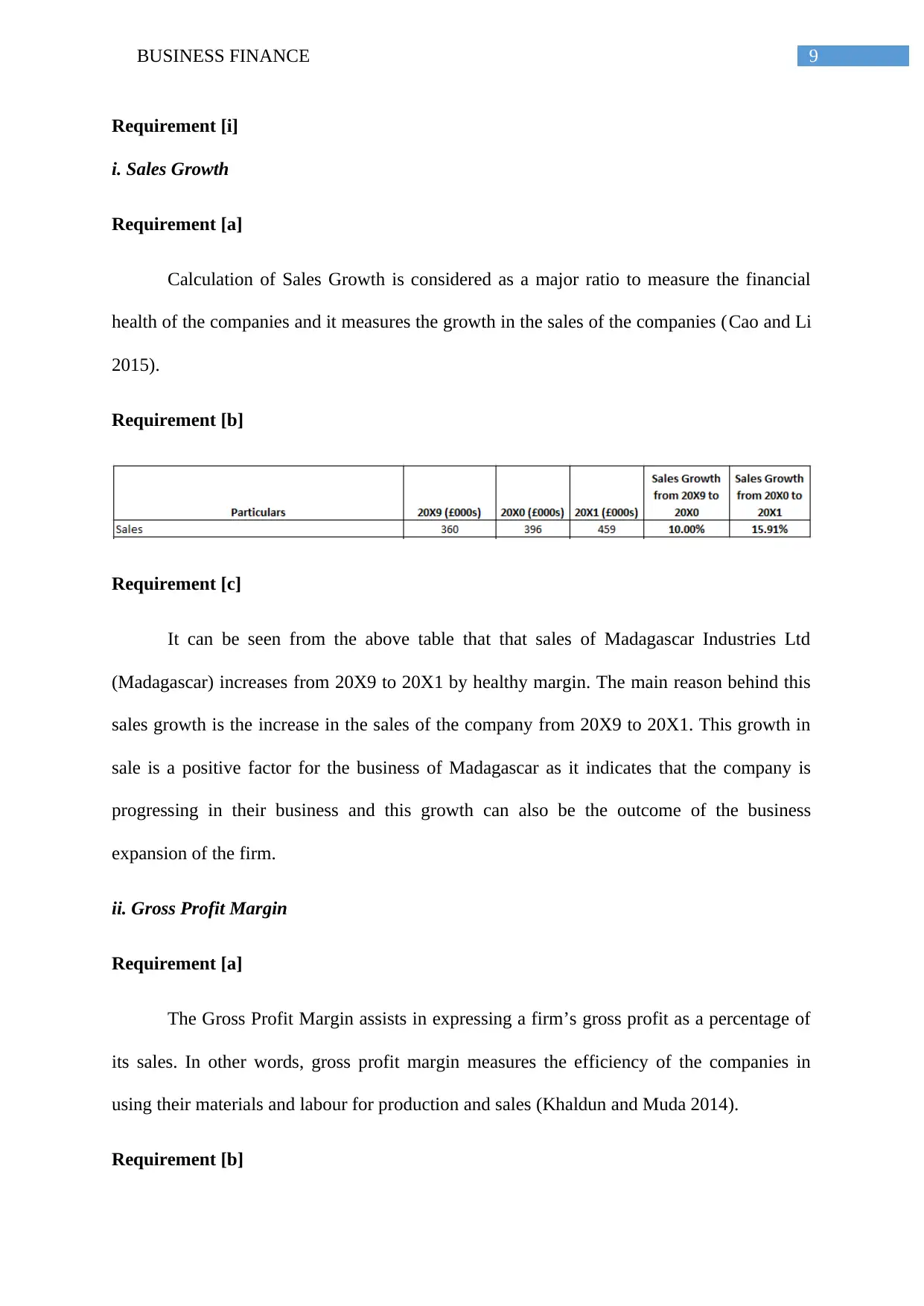
9BUSINESS FINANCE
Requirement [i]
i. Sales Growth
Requirement [a]
Calculation of Sales Growth is considered as a major ratio to measure the financial
health of the companies and it measures the growth in the sales of the companies (Cao and Li
2015).
Requirement [b]
Requirement [c]
It can be seen from the above table that that sales of Madagascar Industries Ltd
(Madagascar) increases from 20X9 to 20X1 by healthy margin. The main reason behind this
sales growth is the increase in the sales of the company from 20X9 to 20X1. This growth in
sale is a positive factor for the business of Madagascar as it indicates that the company is
progressing in their business and this growth can also be the outcome of the business
expansion of the firm.
ii. Gross Profit Margin
Requirement [a]
The Gross Profit Margin assists in expressing a firm’s gross profit as a percentage of
its sales. In other words, gross profit margin measures the efficiency of the companies in
using their materials and labour for production and sales (Khaldun and Muda 2014).
Requirement [b]
Requirement [i]
i. Sales Growth
Requirement [a]
Calculation of Sales Growth is considered as a major ratio to measure the financial
health of the companies and it measures the growth in the sales of the companies (Cao and Li
2015).
Requirement [b]
Requirement [c]
It can be seen from the above table that that sales of Madagascar Industries Ltd
(Madagascar) increases from 20X9 to 20X1 by healthy margin. The main reason behind this
sales growth is the increase in the sales of the company from 20X9 to 20X1. This growth in
sale is a positive factor for the business of Madagascar as it indicates that the company is
progressing in their business and this growth can also be the outcome of the business
expansion of the firm.
ii. Gross Profit Margin
Requirement [a]
The Gross Profit Margin assists in expressing a firm’s gross profit as a percentage of
its sales. In other words, gross profit margin measures the efficiency of the companies in
using their materials and labour for production and sales (Khaldun and Muda 2014).
Requirement [b]
Paraphrase This Document
Need a fresh take? Get an instant paraphrase of this document with our AI Paraphraser
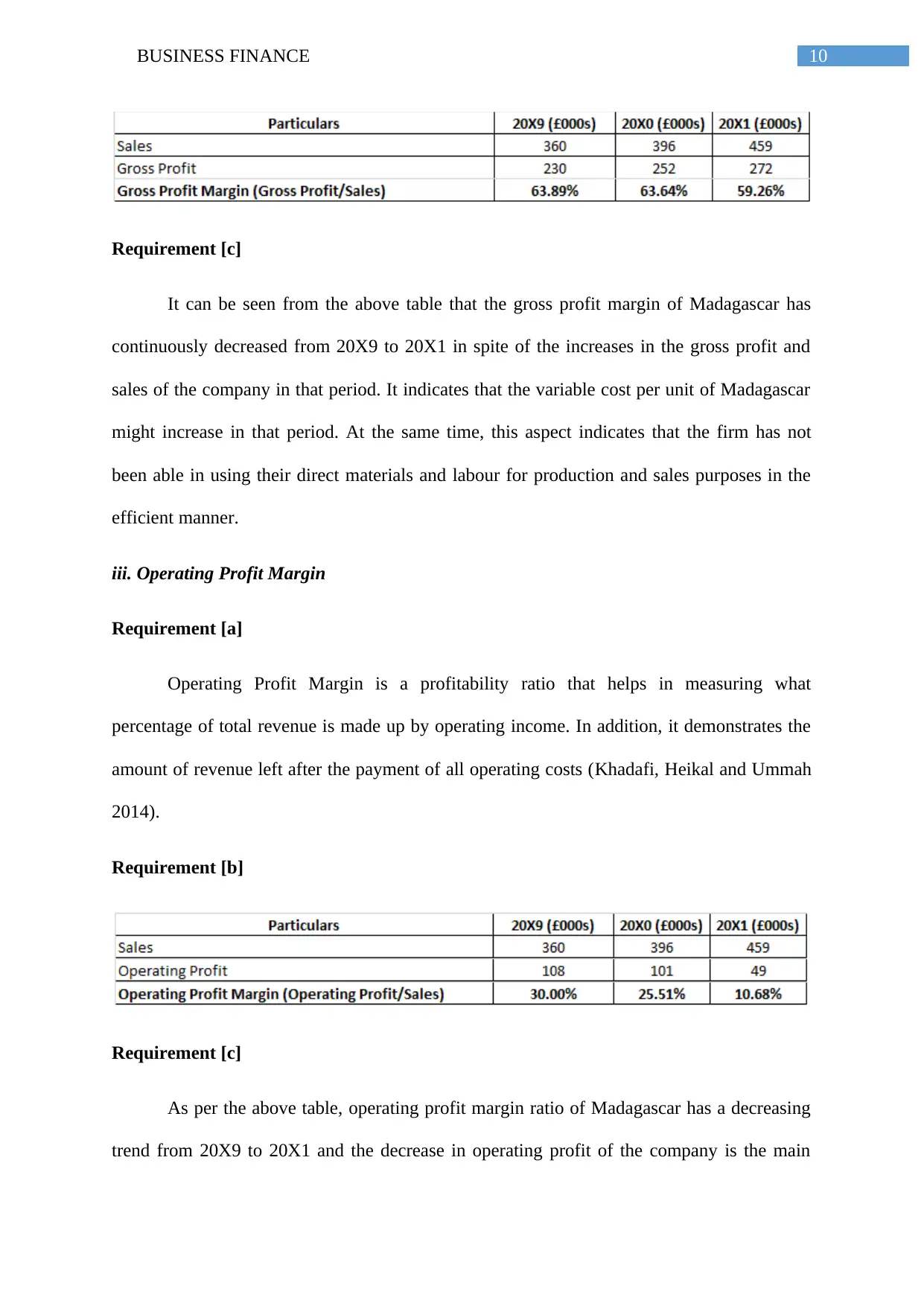
10BUSINESS FINANCE
Requirement [c]
It can be seen from the above table that the gross profit margin of Madagascar has
continuously decreased from 20X9 to 20X1 in spite of the increases in the gross profit and
sales of the company in that period. It indicates that the variable cost per unit of Madagascar
might increase in that period. At the same time, this aspect indicates that the firm has not
been able in using their direct materials and labour for production and sales purposes in the
efficient manner.
iii. Operating Profit Margin
Requirement [a]
Operating Profit Margin is a profitability ratio that helps in measuring what
percentage of total revenue is made up by operating income. In addition, it demonstrates the
amount of revenue left after the payment of all operating costs (Khadafi, Heikal and Ummah
2014).
Requirement [b]
Requirement [c]
As per the above table, operating profit margin ratio of Madagascar has a decreasing
trend from 20X9 to 20X1 and the decrease in operating profit of the company is the main
Requirement [c]
It can be seen from the above table that the gross profit margin of Madagascar has
continuously decreased from 20X9 to 20X1 in spite of the increases in the gross profit and
sales of the company in that period. It indicates that the variable cost per unit of Madagascar
might increase in that period. At the same time, this aspect indicates that the firm has not
been able in using their direct materials and labour for production and sales purposes in the
efficient manner.
iii. Operating Profit Margin
Requirement [a]
Operating Profit Margin is a profitability ratio that helps in measuring what
percentage of total revenue is made up by operating income. In addition, it demonstrates the
amount of revenue left after the payment of all operating costs (Khadafi, Heikal and Ummah
2014).
Requirement [b]
Requirement [c]
As per the above table, operating profit margin ratio of Madagascar has a decreasing
trend from 20X9 to 20X1 and the decrease in operating profit of the company is the main
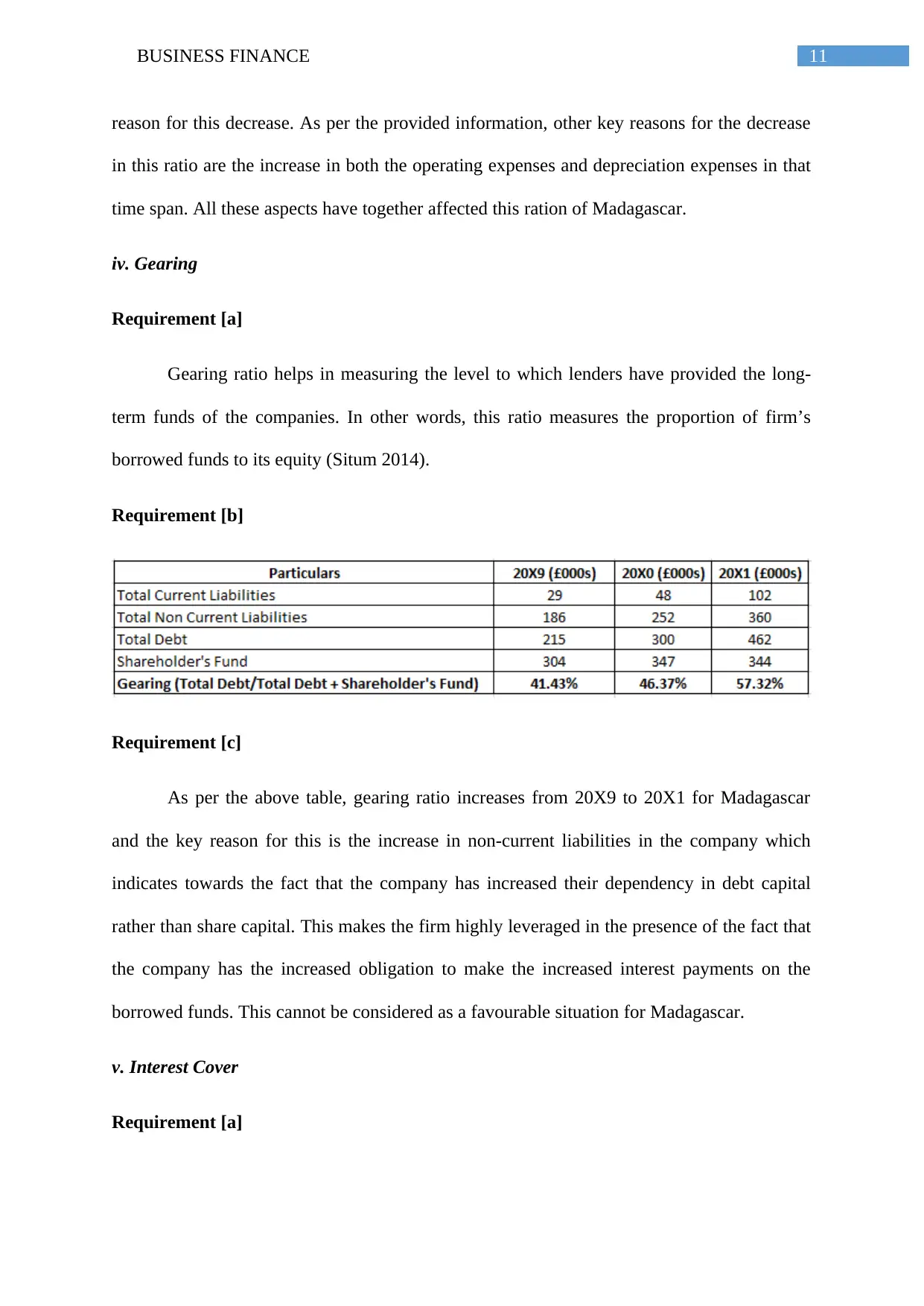
11BUSINESS FINANCE
reason for this decrease. As per the provided information, other key reasons for the decrease
in this ratio are the increase in both the operating expenses and depreciation expenses in that
time span. All these aspects have together affected this ration of Madagascar.
iv. Gearing
Requirement [a]
Gearing ratio helps in measuring the level to which lenders have provided the long-
term funds of the companies. In other words, this ratio measures the proportion of firm’s
borrowed funds to its equity (Situm 2014).
Requirement [b]
Requirement [c]
As per the above table, gearing ratio increases from 20X9 to 20X1 for Madagascar
and the key reason for this is the increase in non-current liabilities in the company which
indicates towards the fact that the company has increased their dependency in debt capital
rather than share capital. This makes the firm highly leveraged in the presence of the fact that
the company has the increased obligation to make the increased interest payments on the
borrowed funds. This cannot be considered as a favourable situation for Madagascar.
v. Interest Cover
Requirement [a]
reason for this decrease. As per the provided information, other key reasons for the decrease
in this ratio are the increase in both the operating expenses and depreciation expenses in that
time span. All these aspects have together affected this ration of Madagascar.
iv. Gearing
Requirement [a]
Gearing ratio helps in measuring the level to which lenders have provided the long-
term funds of the companies. In other words, this ratio measures the proportion of firm’s
borrowed funds to its equity (Situm 2014).
Requirement [b]
Requirement [c]
As per the above table, gearing ratio increases from 20X9 to 20X1 for Madagascar
and the key reason for this is the increase in non-current liabilities in the company which
indicates towards the fact that the company has increased their dependency in debt capital
rather than share capital. This makes the firm highly leveraged in the presence of the fact that
the company has the increased obligation to make the increased interest payments on the
borrowed funds. This cannot be considered as a favourable situation for Madagascar.
v. Interest Cover
Requirement [a]
⊘ This is a preview!⊘
Do you want full access?
Subscribe today to unlock all pages.

Trusted by 1+ million students worldwide
1 out of 19
Related Documents
Your All-in-One AI-Powered Toolkit for Academic Success.
+13062052269
info@desklib.com
Available 24*7 on WhatsApp / Email
![[object Object]](/_next/static/media/star-bottom.7253800d.svg)
Unlock your academic potential
Copyright © 2020–2025 A2Z Services. All Rights Reserved. Developed and managed by ZUCOL.





